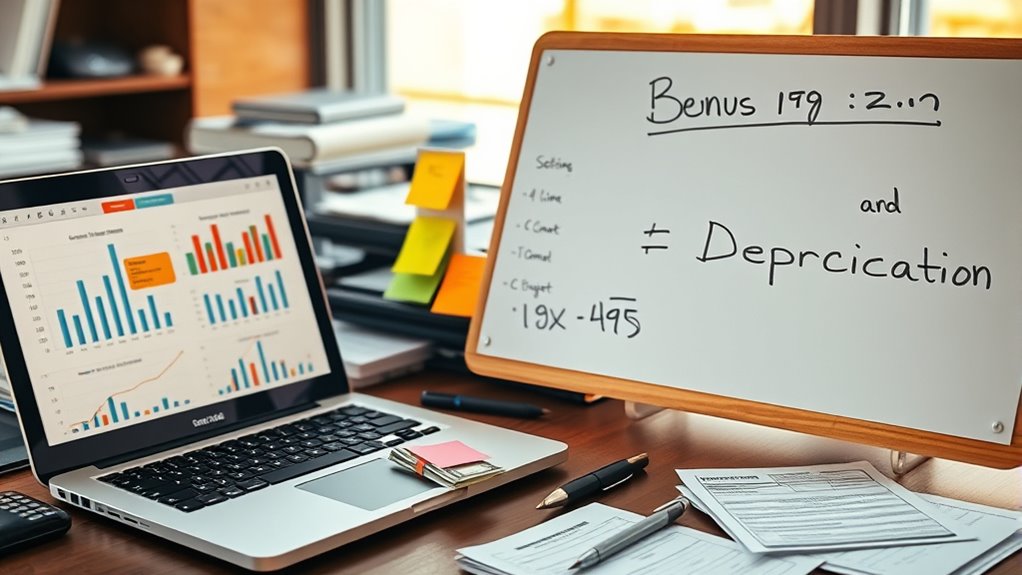To choose between Section 179 and bonus depreciation, consider your business size, income, and asset types. Section 179 offers immediate deductions up to a $1,250,000 limit but phases out after $3.13 million spent, making it ideal for smaller purchases. Bonus depreciation provides broader coverage with no dollar cap, especially useful for large investments. Understanding how these options work helps optimize your tax savings; exploring further reveals which strategy suits your needs best.
Key Takeaways
- Section 179 offers immediate expensing with annual limits, ideal for smaller purchases, while bonus depreciation has no cap and can cover larger investments.
- Bonus depreciation applies to both new and used property, including land improvements, whereas Section 179 excludes land and certain real estate.
- Use Section 179 first up to its limit, then apply bonus depreciation for additional deductions, optimizing total write-offs.
- Larger businesses or industries with heavy equipment purchases often favor bonus depreciation due to its unlimited scope.
- Timing and business income levels influence which method maximizes tax benefits—consider strategic planning for year-end purchases.
Understanding the Basics of Section 179 and Bonus Depreciation

To understand the basics of Section 179 and bonus depreciation, it’s important to know that both are tax incentives designed to help businesses recover the costs of their investments more quickly. They apply to different asset types, including tangible personal property and certain real property improvements. Section 179 allows immediate expensing of qualifying assets, mainly for tangible personal property and specific real estate, but excludes land. Bonus depreciation offers broader coverage, including alternative asset types like some used property and land improvements. While both incentives are primarily for U.S.-based businesses, their principles have international applicability, especially for companies with global investments. These incentives reduce taxable income in the year of purchase, providing liquidity benefits, but their rules and asset eligibility vary. Additionally, understanding breast cancer symptoms can be crucial for early detection and treatment.
Comparing Deduction Limits and Caps

Understanding the deduction limits and caps for Section 179 and bonus depreciation reveals key differences in how they impact your business’s tax strategy. Section 179 allows a maximum deduction of $1,250,000 in 2025, phasing out dollar-for-dollar after $3,130,000 spent, with complete exclusion beyond $4,380,000. It applies to new and used equipment, including software expenses, but is limited by your taxable income. Bonus depreciation offers a 40% rate for qualifying property, with no dollar limit, and applies after Section 179 deductions. It covers vehicles, tangible property, and software, with no phase-out. Unlike Section 179, bonus depreciation isn’t limited by income, making it useful for larger investments or employee benefits like fleet upgrades. These caps influence how much you can deduct annually and shape your planning. Additionally, understanding the role of projectors in home cinema setups can help optimize your entertainment space.
Timing and Phase-Down Schedules Explained
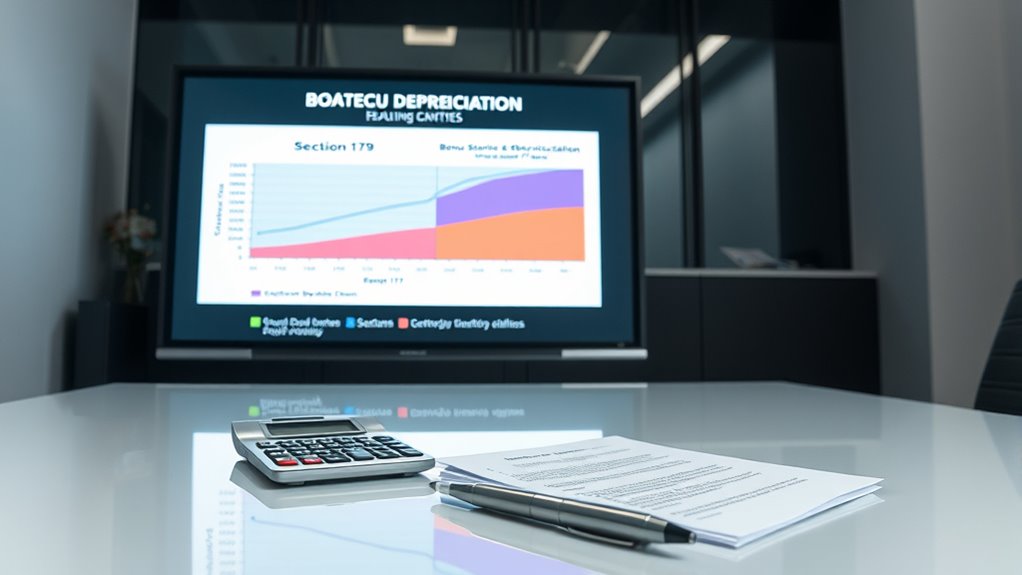
The timing of your equipment purchases can substantially impact your tax savings, especially with the bonus depreciation phase-down schedule. As bonus depreciation decreases each year through 2026, planning when to buy becomes vital to maximize deductions. Since Section 179 remains permanent, understanding these schedules helps you decide the best approach for your business investments. Knowing how these schedules change enables more strategic decision-making to optimize your tax benefits.
Section 179 Yearly Limits
Section 179 limits for 2025 are designed to help small and medium-sized businesses maximize immediate deductions while preventing larger companies from gaining an unfair advantage. If you’re financing equipment or considering lease terms, keep in mind that the maximum deduction is $1,250,000. This applies to both new and used equipment placed in service during 2025, as long as it’s used more than 50% for business. The deduction begins to phase out once your total qualifying property exceeds $3,130,000, with complete phase-out at about $4,380,000. If your equipment purchases surpass these thresholds, you can still benefit from bonus depreciation. Remember, your ability to claim the deduction is also limited by your business’s taxable income, with any unused amount carried forward.
Bonus Depreciation Phase-Out Schedule
Bonus depreciation has experienced significant changes since its inception under the 2017 Tax Cuts and Jobs Act (TCJA). Originally, it allowed 100% bonus depreciation for qualified property placed in service after September 27, 2017. The TCJA scheduled a gradual phase-out, reducing bonus depreciation to 80% in 2023, then 60% in 2024, 40% in 2025, and 20% in 2026, with full elimination after 2026 unless legislation changes. Recently, the 2024 Tax Relief for American Families and Workers Act reversed this schedule, reinstating 100% bonus depreciation starting in 2025. This phase-out schedule impacted tax planning by shifting benefits over time, but the recent reinstatement offers businesses a short- to mid-term opportunity for full expensing, altering the typical phase-out trajectory. The legislation’s impact on depreciation planning remains a key consideration for many taxpayers.
Strategic Purchase Timing
Understanding the timing of equipment purchases is essential for maximizing tax benefits, especially as depreciation rules and limits change over the years. You should consider equipment financing options, such as leasing versus buying, to optimize deductions. Since the 2025 Section 179 limit is $1,250,000 with a phase-out starting at $3,130,000, timing your purchases before these thresholds can maximize immediate deductions. Bonus depreciation, at 40% in 2025, decreases afterward, making early-year purchases more advantageous. Whether you choose to lease or buy, strategic planning around year-end can help you leverage current limits and avoid phase-outs. Proper timing guarantees you benefit from full deductions now while aligning with your long-term growth and cash flow strategies. Being aware of depreciation phase-down schedules is crucial for effective tax planning. Additionally, understanding depreciation limits and schedules can help you better forecast your deductions and avoid unexpected reductions in future years.
Asset Eligibility for Each Deduction Method
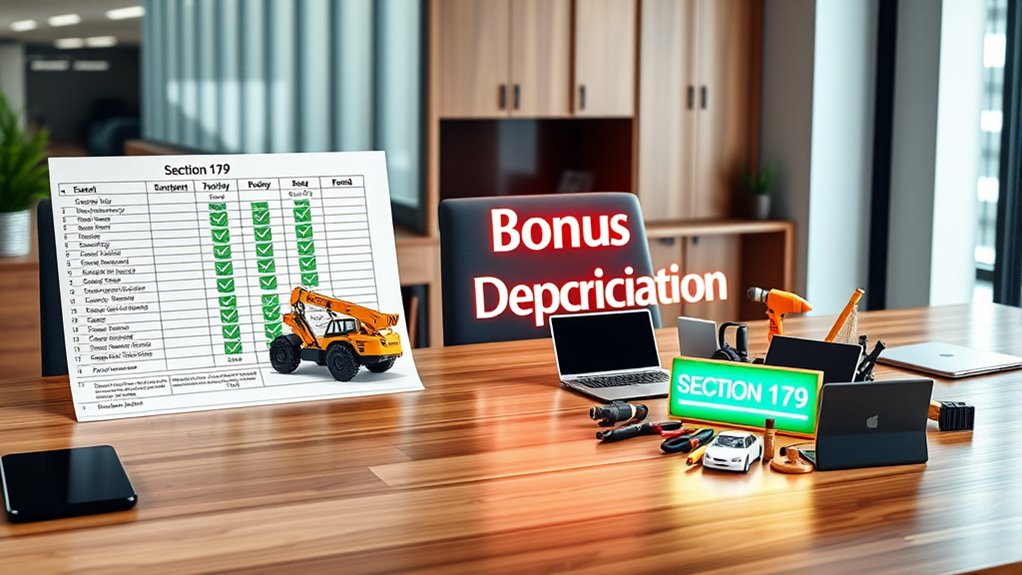
Not all assets qualify equally for depreciation deductions, so understanding which property is eligible is essential for maximizing your tax benefits. Your asset classification determines whether it can be expensed through Section 179 or bonus depreciation. Here’s a quick overview:
Not all assets qualify for depreciation; proper classification maximizes your tax benefits.
- Section 179 applies to new and used equipment, manufacturing machinery, vehicles (over 6,000 lbs GVWR), computers, office tech, and furniture.
- Bonus depreciation covers both new and used property that qualifies under MACRS, including machinery, equipment, and some vehicles after Section 179 limits are reached. Asset qualification criteria must be met to ensure eligibility.
- Asset depreciation rules specify that assets must be used more than 50% for business and placed in service within the tax year. Some property types, like real estate, are excluded from these deductions.
- Qualifying property must meet specific criteria, including being purchased new or used and having a useful life of 20 years or less for bonus depreciation purposes.
How Income Levels Impact Write-Off Choices
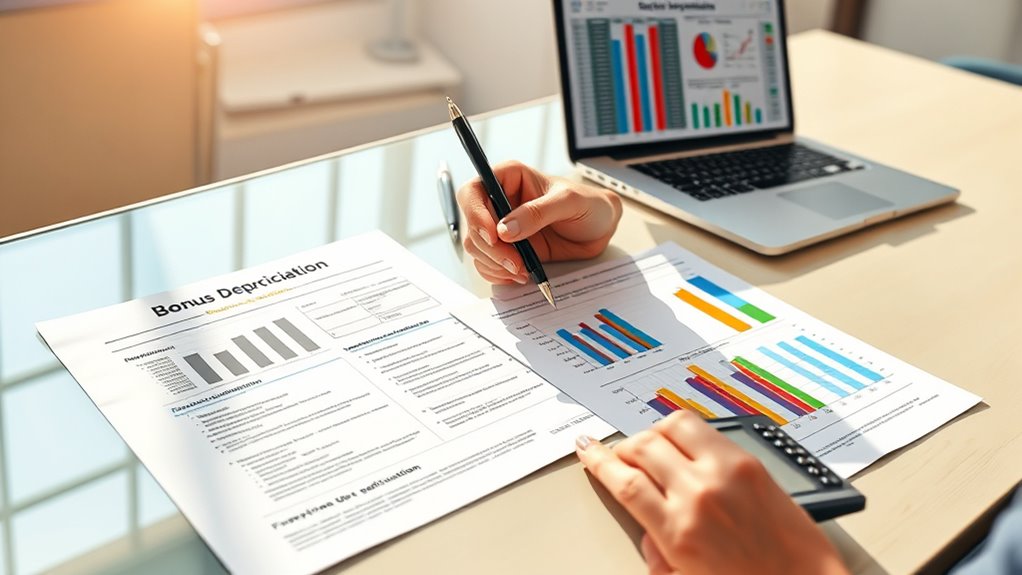
Your income level plays a key role in choosing between Section 179 and bonus depreciation. If your taxable income is limited, bonus depreciation might be more beneficial since it can create losses and isn’t restricted by income caps. Additionally, astrological signs have been associated with different perceptions of attractiveness, which can influence personal branding and confidence in business contexts. Conversely, higher-income businesses may prefer Section 179 to maximize deductions within its limits. Because of the income limitations, businesses with higher profits can take full advantage of Section 179 deductions without concern for restrictions.
Income Limits Matter
Income levels play a crucial role in determining how you can maximize your depreciation deductions. If your business has high taxable income, you can fully utilize the Section 179 deduction limit of $1,160,000, which offers immediate tax savings and fits into your depreciation schedule. Conversely, lower or no taxable income restricts your ability to use Section 179, since deductions can’t exceed active business income. Bonus depreciation, however, has no income limit, allowing you to claim large deductions even with little or negative income. Additionally, the ability to carry forward unused Section 179 limits can help optimize your depreciation over multiple years despite income fluctuations. Consider these points: 1. High income enables full use of Section 179 and tax credit options. 2. Low income limits your Section 179 deductions, but bonus depreciation remains available. 3. Carryforward rules help maximize deductions over multiple years despite income fluctuations.
This interplay influences your overall depreciation strategy.
Deduction Flexibility Varies
The ability to choose between Section 179 and bonus depreciation depends heavily on your business’s taxable income. If your income is high, you can fully utilize Section 179 to maximize immediate deductions, especially with lease options for equipment. However, if your income fluctuates or is lower, bonus depreciation offers greater flexibility, as it can create or increase a net operating loss without income limits. This allows you to accelerate deductions in loss years or when income dips, supporting tax credit strategies. Combining both methods lets you optimize deductions based on your income situation. Remember, Section 179 deductions are limited by taxable income, while bonus depreciation can absorb excess costs and generate losses, giving you more deduction flexibility regardless of income fluctuations.
Loss Generation Potential
When choosing between Section 179 and bonus depreciation, understanding how taxable income influences your options is key. Bonus depreciation can generate or increase net operating losses (NOLs), offering flexibility in tax planning, especially for loss-generating businesses. In contrast, Section 179 cannot create losses and is limited by income, making it less suitable for companies expecting negative income. Consider these points:
- High-income businesses use Section 179 to maximize immediate deductions, reducing taxable profit.
- Lower-income or loss businesses prefer bonus depreciation to shelter income or generate losses for future carryforwards.
- Bonus depreciation’s ability to produce NOLs supports long-term strategic asset management, smoothing income fluctuations.
- The IRS rules stipulate specific limits and qualifications that can impact how and when these deductions are utilized.
Choosing the right method depends on your income level, with implications for Alternative Asset Strategies and overall tax planning.
Strategic Planning for Maximizing Tax Benefits

To maximize your tax benefits through asset purchases, strategic planning around Section 179 and bonus depreciation is essential. Focus on tax planning by classifying assets correctly to optimize deductions. Use Section 179 first for eligible property, leveraging its deduction limits and flexibility. Apply bonus depreciation to remaining assets, especially large purchases without limits. Timing is vital; placing assets in service before year-end maximizes deductions and minimizes phase-down impacts. Consider how asset types and business income influence your choice. The table below summarizes key strategies:
| Strategy | Asset Classification & Timing |
|---|---|
| Prioritize Section 179 | Use for tangible property under limits |
| Apply bonus depreciation | Use for large or qualifying assets beyond limits |
| Optimize timing | Place assets in service before year-end |
| Balance asset types | Match property use with deduction rules |
Additionally, understanding the main factual point that bonus depreciation percentage decreases over time can help in planning for future years’ deductions. Recognizing how depreciation percentage declines is crucial for effective tax planning and maximizing current-year benefits.
Business Size and Industry Considerations

Business size and industry type considerably influence how you should approach asset depreciation strategies. Industry adaptation and business scale determine whether you benefit more from Section 179 or bonus depreciation. Here’s what to contemplate:
- Small to mid-sized businesses often favor Section 179 for immediate deductions, especially if their purchase amounts stay under annual limits.
- Larger businesses or those with significant capital expenditures usually utilize bonus depreciation, which has no maximum limit and can offset extensive asset costs.
- Industry-specific asset eligibility matters: construction and retail industries may prioritize Section 179 for equipment and improvements, while manufacturing or tech firms lean on bonus depreciation for machinery and used assets.
- Business size and industry influence the optimal depreciation strategy based on eligibility thresholds and asset types. Matching these factors helps optimize your depreciation approach for your business’s size and industry.
Making the Right Choice for Your Business
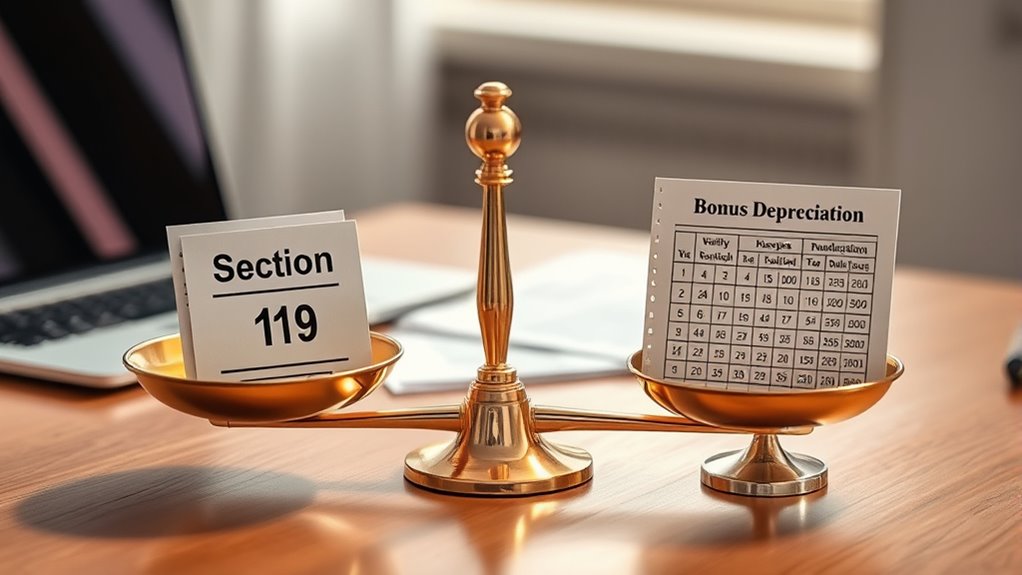
Choosing between Section 179 and bonus depreciation hinges on your company’s financial situation, asset purchase plans, and long-term tax strategy. If you prefer immediate full deductions, Section 179 offers upfront write-offs up to its limits, ideal for businesses with enough taxable income. Bonus depreciation provides unlimited deductions, making it useful for companies expecting losses or using alternative financing options like leasing, where ownership isn’t immediate. If you plan to purchase equipment outright, buy versus lease decisions influence your choice—buying assets allows full expensing, while leasing may limit your ability to maximize deductions. Keep in mind the phase-down schedule for bonus depreciation, which decreases its benefit over time. Combining both methods strategically can optimize your deductions, balancing short-term savings with long-term planning.
Frequently Asked Questions
Can a Business Switch Between Section 179 and Bonus Depreciation Each Year?
You can switch between Section 179 and bonus depreciation each year because of their switching flexibility and deduction timing advantages. You make the election annually on your tax return, allowing you to choose the most beneficial method based on your business’s current income and asset purchases. This flexibility helps optimize your tax savings, but it’s wise to consult with an accountant to confirm you’re applying the rules correctly each year.
How Do State Tax Laws Affect These Federal Deduction Options?
Think of federal deduction options as a garden, but regional depreciation rules are the weather that influences growth. State tax implications can either nurture or hinder your deductions, depending on whether your state fully, partially, or doesn’t conform to federal rules. These regional differences affect your taxable income, requiring you to adapt your strategies accordingly. Staying aware of local laws helps you maximize your deductions and avoid surprises in your tax landscape.
Are There Specific Asset Types That Qualify for One Deduction but Not the Other?
You’ll find that equipment limitations and asset classification determine which deduction applies. Some assets, like land improvements, qualify for bonus depreciation but not for Section 179. Conversely, certain real estate upgrades, such as roofs or HVAC systems, can be expensed under Section 179 but not bonus depreciation. Understanding these asset classifications helps you choose the right deduction, maximizing your tax benefits based on asset types and their eligibility.
What Are the Audit Risks Associated With Claiming Large Depreciation Deductions?
Did you know that large depreciation deductions can trigger audit red flags? Claiming big write-offs increases the risk of errors or fraud, especially if documentation requirements aren’t met. Inaccurate assumptions about asset useful life or residual value can lead to misstatements. Relying on inconsistent calculations or failing to substantiate deductions with proper records raises audit concerns, emphasizing the importance of accurate documentation to defend your claims and minimize audit risks.
How Do These Deductions Impact My Business’S Overall Tax Strategy?
Your deductions shape your overall tax strategy by influencing cash flow and taxable income. Effective tax planning involves understanding asset classification to decide whether to use Section 179 or bonus depreciation. By strategically applying these deductions, you can maximize immediate savings, manage taxable income, and potentially generate net operating losses. Properly planning asset classification guarantees you optimize deductions, align with income forecasts, and improve your business’s financial health over the long term.
Conclusion
So, now that you’re a tax deduction expert, go ahead and pick your favorite write-off—because who doesn’t love a little financial drama? Whether you choose Section 179 or bonus depreciation, just remember: it’s all about maximizing your savings while keeping the IRS guessing. Just don’t get too sentimental—after all, these deductions aren’t exactly your business’s best-kept secrets, even if they feel like it. Happy saving!
